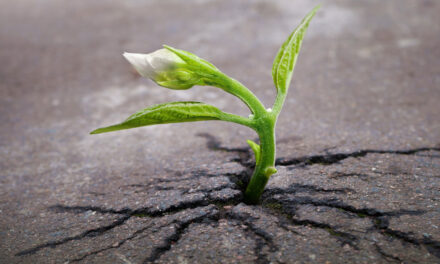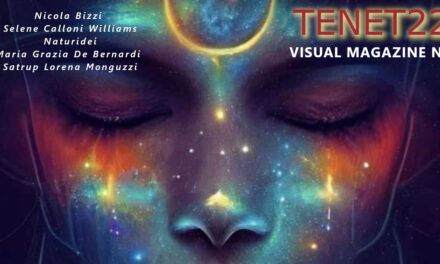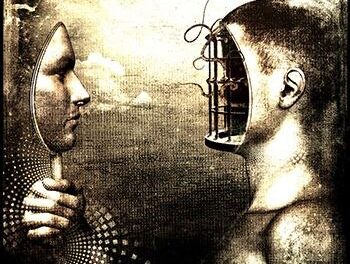“Here, O Sariputra, form is emptiness and emptiness is form; emptiness does not differ from form, form does not differ from emptiness; whatever is form, that is emptiness; whatever is emptiness, that is form.”.
(The Heart Sutra)
We live in a virtual world and we have to discover and figure it out.
The great deception is precisely believing in the objectivity of things, that is, in a substantial and concrete reality that is not emptiness.
This is not a nihilistic position, and in fact in the Buddhist vision, emptiness is not nothingness. It is the pure will to exist. But existing means to be there for death. Therefore, the aspiration to exist is the will to give oneself, to offer oneself. Existence is elusive, by virtue of its intrinsic nature.
“One cannot descend into the same river twice and one cannot touch a mortal substance twice in the same state, but due to the impetuosity and speed of change it disperses and it gathers again, it comes and it goes.”
(22 B 91 Diels-Kranz)
We live in a virtual world where material things appear real, in reality they are dreams, illusions, images. We live in a mundus imaginalis which is also a mundus symbolicus.
In this world, nature, with its characteristic of impermanence, appears to be the main symbol of the “sacrum facere“, of giving one own self.
But what is nature?
If we start from the assumption that “nature” is something that can be contrasted with something else, then we have nothing natural in our world: even the word written in the Bible. From the smoke signals of primitive people, from the club to today’s computers, everything that man produces can be contrasted with nature. But this position makes no sense, because man is a product of nature. The nature/culture separation does not hold. Better to include our cultural and technological transformation in the great evolutionary push that nature represents, a gigantic evolutionary push that moves towards ever higher degrees of freedom.
The word “nature” itself indicates change. It comes from the Latin “natura” which means “that which is about to be born” and which in turn is the Latin translation of the Greek physis (φύσις). Nature is understood as a becoming or a continuous generation of forms. Its constants are transformation, change, diversity.
The nature/culture contrast comes into being and acquires meaning in an Abrahamic vision, in which God lives in a distant sky, distinct and separated from nature itself. On this idea of God, the concept of a metaphysical principle is built, the mind, which is separate from nature and is capable of dominating it.
Each individual, then, on the basis of the experiences he had in childhood and adolescence, on the basis of his own memories, will develop the impression of a good God, like a generous and protective parent, and therefore of a reliable mind. Or he will manifest the feeling of an evil God, an indifferent parent, and therefore an evil mind.
They are both two religious positions: the first leads to seeing science and technology as a sort of salvific religion, while the second leads to seeing science and technology as an evil religion.
To put it in other words, we will have individuals who attribute a salvific power to the mind and its products, culture, science, technology, and other individuals who, instead, attribute a malevolent power to the mind, science and technology.
The starting point remains the same for everyone. It is in having placed the idea of God outside of nature, in a distant sky which, in the end, is more or less consciously superimposed on the concept of mind.
When a primitive man prays “Thy Will be Done”, he turns to the wolf, the owl, the gazelle, the rain, the wind. For primitive man, God and nature coincide, therefore the mind can only be at his service.
The theme of the contrast between nature and culture is a religious problem, that is, a problem that arises in the context of a religion made to measure for empires to serve a civilization that is characterized by an exasperated desire for power.
It is necessary to choose love rather than power for everything to radically change, and for nature and culture to find their creative synthesis.
For those who have chosen the spiritual path, which is the path of the sacred and of love, rather than that of the religion of power, science and technology can represent extraordinary aids for living in the synthesis of nature and culture to a very high degree.
As the President of the Imaginal Academy, which was founded in Switzerland by the Nontherapy Association in 2003, I am very proud to have been able to announce about a year ago the launch of the first virtual environment in Europe where to meditate. It’s called Virtual Imaginal Academy and it is an environment specifically created for meditation. It is a place that recalls the landscapes in which the Nontherapy Association organizes its travels and researches: Mongolia, Japan, Himalaya, Siberia, South America, etc.
The practitioners can meet on the Siberian steppe, dip in a stream and gather in a yurt. They can play the drum, pull out a card, draw, dance with their animal spirit and animate their totem, and finally gather in meditation at the sound of a bell.
Virtual Imaginal SCW is the first project in Europe that brings meditation, spiritual ritual, counseling and life coaching into virtual reality.
For those who have chosen the spiritual path, which is the path of the sacred and of love, rather than that of the religion of power, science and technology can represent extraordinary aids for living in the synthesis of nature and culture to a very high degree.
Over the last year we have held various meditation and virtual reality seminars in person at our headquarters in Vienna and implemented the “virtualimaginalacademyscw” website, which can be accessed directly from the website https://selenecalloniwilliams.com. Some spaces in our metaverse are free and open to all, others are reserved for subscribers to our premium membership. It is not necessary to have the oculus to visit our virtual sites, but, obviously, with the oculus you have total immersion in virtual reality.
How can virtual reality help the imaginal process?
“Everyone sees the form with which I won, but no one knows what leads me to decide the form of victory. Avoid repeating the victorious tactics of the past, because the form must be suggested by the infinite variety of circumstances.”
(Sun Tzu, “The Art of War”)
The imaginal is the great liminal threshold between the conscious and the unconscious. It is there that all the images that become events in our lives are born. In the East, the imaginal could be defined as the great land of the Buddhas of the present, the past and the future, Shangri-La, the Great Middle Earth. Whoever manages to reach the imaginal becomes the conscious co-creator of events. It is said that the magician, the shaman, the mystic, dwell in the imaginal, where their consciousness, perfectly centered between opposites, is able to produce change in accordance with their will, which has become one with the cosmic will.
To reach the imaginal it is necessary to dissolve the impression of objective reality.
The experience of augmented or virtual reality can help us carry out the three operations necessary for this purpose: dematerialize, depersonalize, delegitimatize our experience of reality.
Spiritual procedures have always adapted to the times and to man, who changes according to the times in which he lives. We live in circumstances where technology has taken on a preponderant role, it is everywhere in our lives. The practitioner who does not take this into account risks to repeat the methods of the past and to miss the purpose of his spiritual path.
This does not mean that today we necessarily have to enter a virtual environment in order to meditate, but simply that someone, a pioneer with a good spirit of adventure, can explore this reality. In the end, as always happens, the experience of one becomes the experience of all, because when an individual learns something, he actually learns it for the whole species.
Today, the common thought is that, in the age of computers and internet, we are no longer able to have complete sensory experiences, that is, to use all five senses simultaneously. Augmented reality dispels this common thought and provides us with the key to a new anthropology in which being human is a little closer to nature, understood as the continuous generation of forms that coincide with emptiness. All this is destined to revolutionize our concept of death, birth and becoming.
Virtual reality and artificial intelligence place us on the threshold of an epochal revolution where some will be protagonists, others followers and still others risk being victims.
Virtual reality and artificial intelligence place us on the threshold of an epochal revolution where some will be protagonists, others followers and still others risk being victims.
Surely, like every revolution, this too is accompanied by a redefinition of the central idea of man, the idea of God. It can no longer be placed in a distant sky, nor in a substantial nature. Both the metaphysical sky and substantial nature reveal themselves. I believe that this revolution will see the idea of God leave the mind and enter the imagination and, however absurd it may seem, since we are talking about a technologically based revolution, it will revive the mythical thought of primitive man, the poetic and symbolic mind that created the myth and with it the original form of all our experiences. We will go back to the origin and start all obver again.
“The history of man presents nothing other than a continuous passage from one level of civilization to another, then to excess of civilization, and finally to barbarism, and then all over again.”.
(Giacomo Leopardi, “Lo Zibaldone”)










